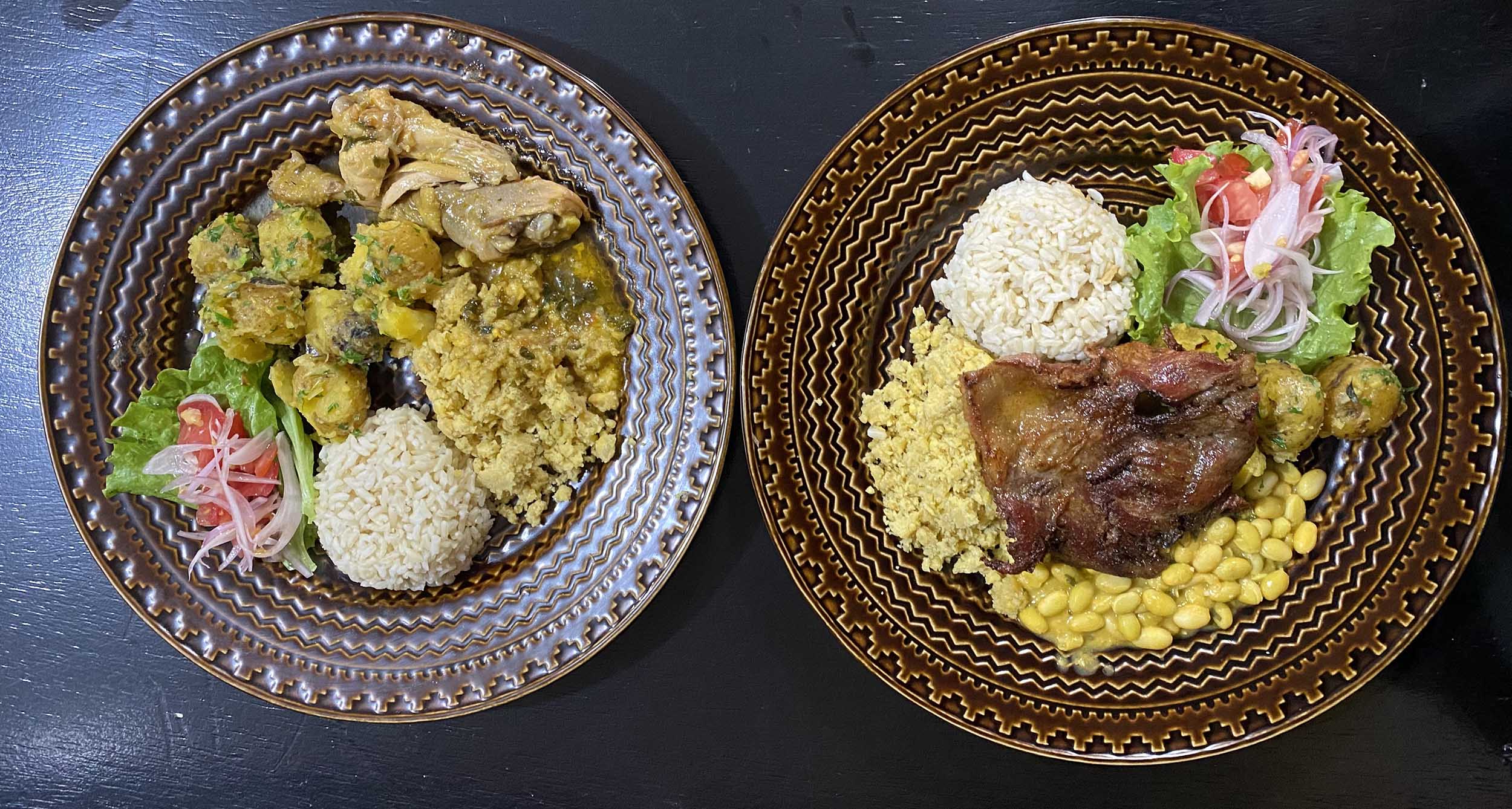
What to Eat in Ecuador
What to Eat in Ecuador
We conducted a survey in our office to find out everyone’s favorite Ecuadorian dishes.
Some of the top mentions were ‘Locro de papa,’ ‘Hornado con tortillas,’ ‘Papas con cuero,’ ‘Cuy con papas y salsa de maní,’ and ‘todos los Mariscos.’ Naturally, since our office is located in Quito, high in the Andes, the choices reflect mostly the rich flavors of Andean cuisine.”
What counts for Ecuador’s natural and cultural diversity also applies to its cuisine: every region, every village and even every family has its own specialties and recipe variations.
Ecuadorian cuisine by region:
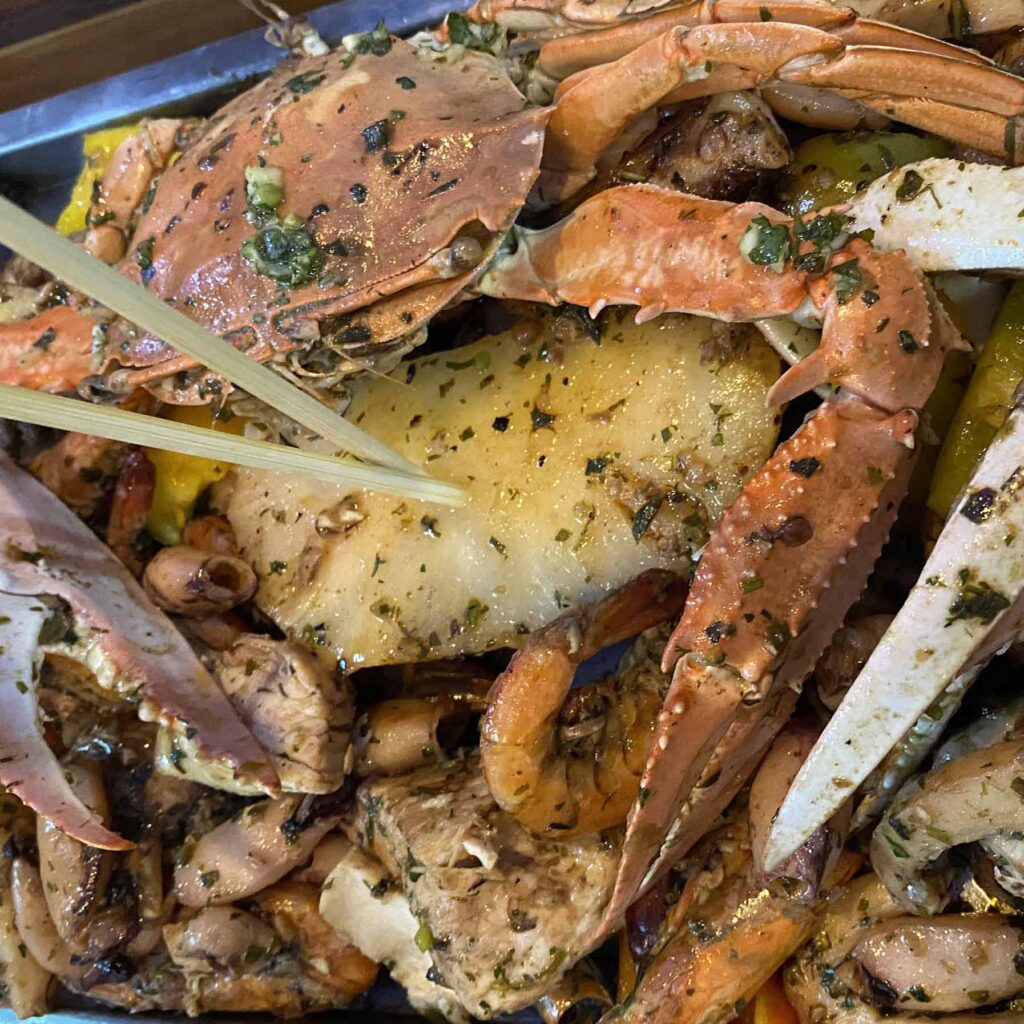
Coastal Region (La Costa):
The cuisine here is heavily influenced by the sea, featuring “marisco”, seafood dishes like “ceviche”, a marinated seafood dish typically made with shrimp, fish, or shellfish, served with lime juice, onions, tomatoes, and cilantro. Plantains are a staple in this region, often served fried as “patacones” or “bolones”. Famous in the northern coast are the “encocado”, a fish or shrimp dish cooked in a coconut milk sauce.
But also “Seco de chivo” goat stew with rice and “Seco de pollo” chicken meat with avocado strips and rice are served everywhere.
Andean Highlands (La Sierra):
The highlands offer heartier fare, often featuring potatoes, corn, and grains like quinoa. “Llapingachos”, potato patties stuffed with cheese, are popular, as is “locro de papa”, a rich potato soup often topped with avocado and cheese. Special main courses are: “Cuy” roasted guinea pig; “Hornado” or “Fritada” roasted or fried pork accompanied by “Tortillas de maiz” corn pancakes; “Lomo salteado” beef with tomatoes and onions and “papas con cuero” pork skin stewed until super soft and then together with potatoes cooked into a rich broth.
But also, the different “Empanadas” are everybody’s favorites: These pastries are filled with various ingredients, from cheese to meat or even sweet fillings, and then fried or baked.
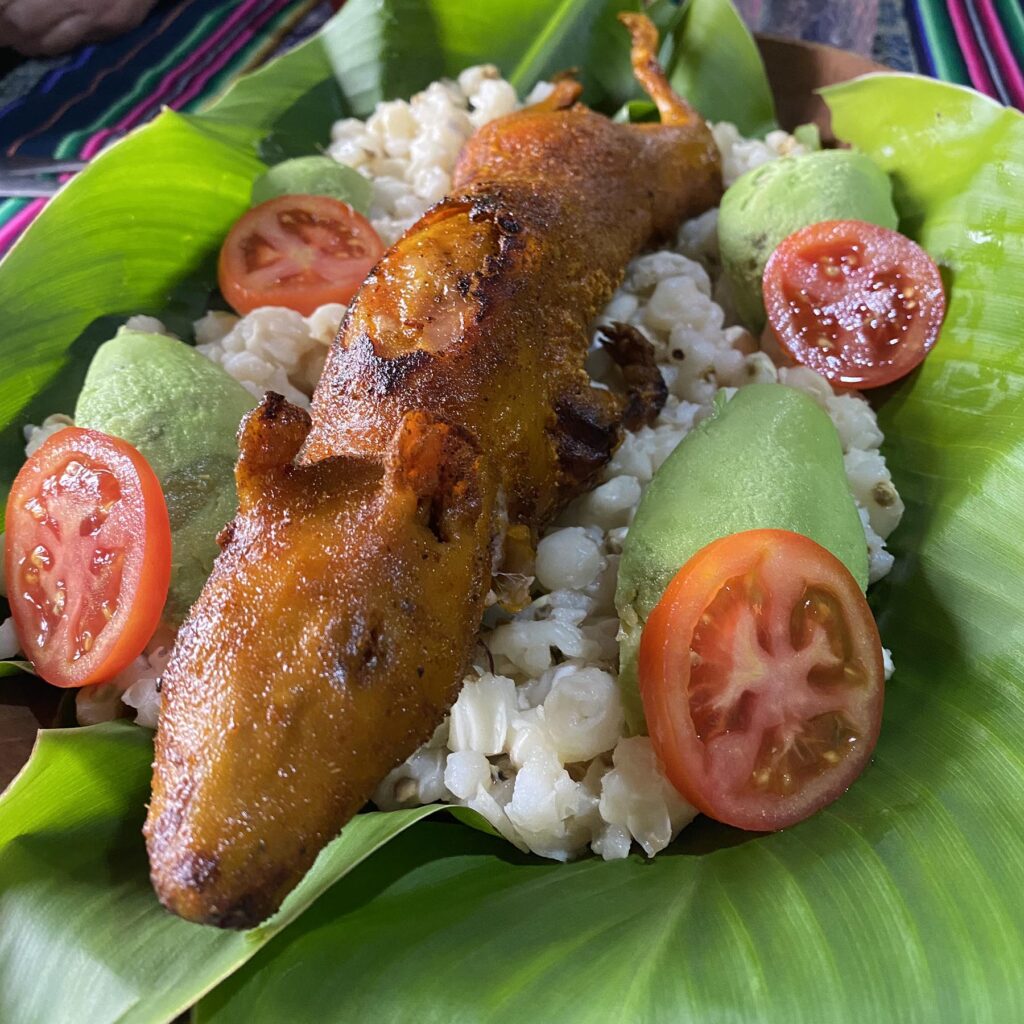
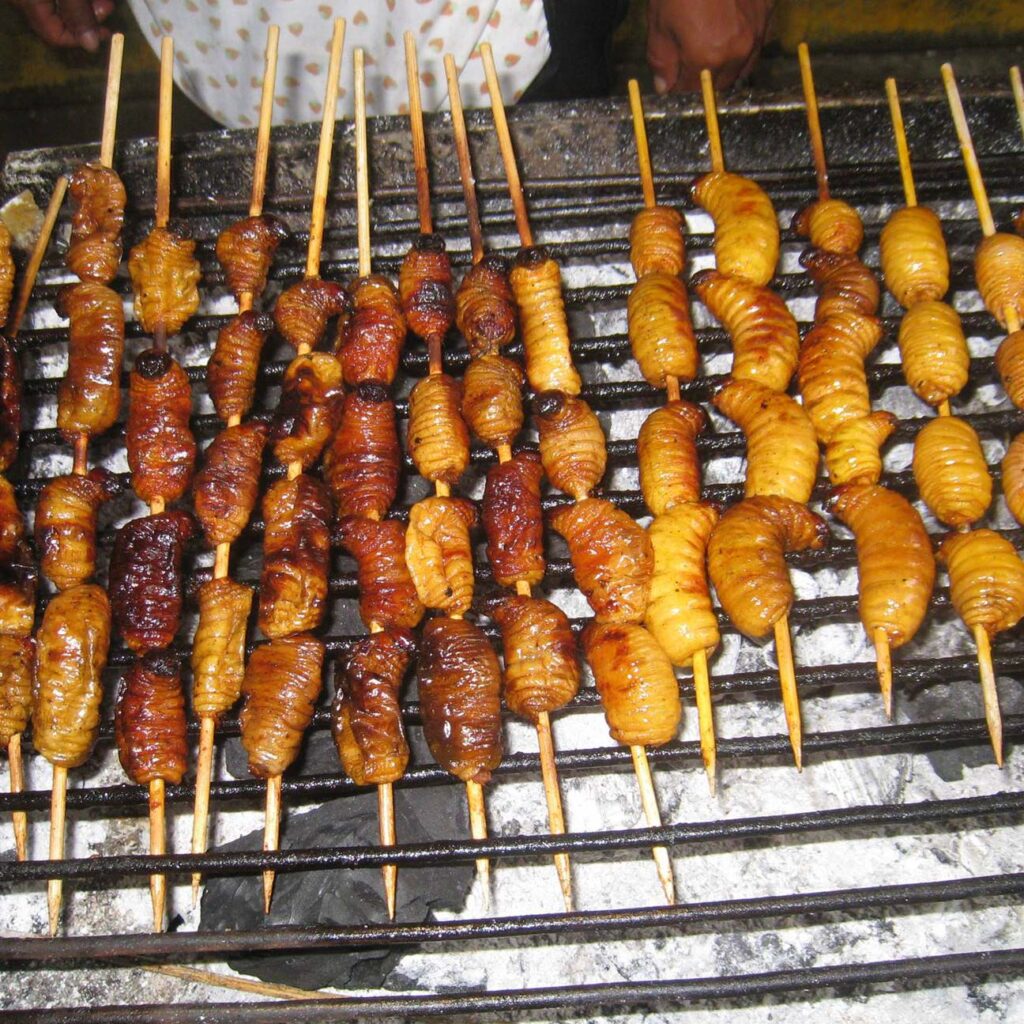
Amazon Region (El Oriente):
The Amazon’s cuisine is unique, with indigenous influences. Dishes here include “maito”, fish wrapped in leaves and cooked over an open flame, and “chontacuro”, grilled palm weevil larvae, considered a delicacy. Manioc (yuca) is a staple, often made into “chicha” a lightly fermented thick drink.
Galápagos Islands:
The cuisine here is a blend of seafood and traditional Ecuadorian dishes. Fresh fish, lobster, and octopus are common, often prepared simply to highlight their natural flavors.
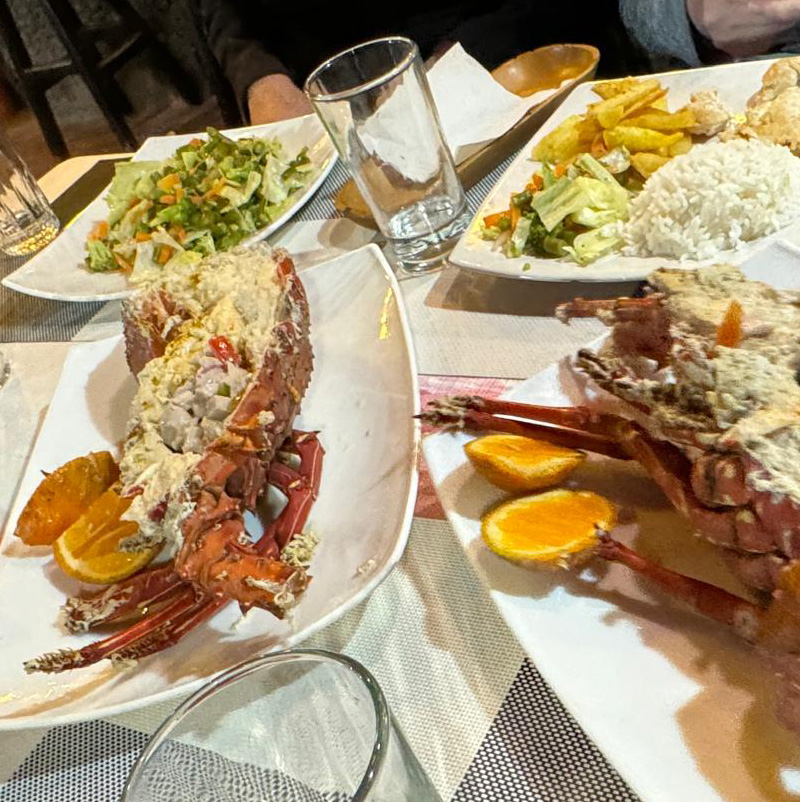
A note on street food and exotic fruits
Street Food is a vibrant part of Ecuadorian culinary culture. Ecuadorians are known to eat the whole time, from a hearty breakfast to ice cream in the afternoon and an early pre-dinner before going home.
You can find dishes like “empanadas de viento” (cheese-filled, fried pastries),
“llapingachos”, and grilled meats on skewers, known as “pinchos” and “humitas” fresh corn combined with fresh cheese wrapped in corn husks and steamed almost in every streetcorner in the Andes. At the coast look out for “bolón de verde” a filled green plantain ball or a “ceviche” and a freshly cut and opened coconut. But you will find also market stands for all the fresh exotic fruits of the regions. Sometimes they are served already peeled and cut or as a fresh juice. On the way to Otavalo look out for “chirimoyas” the Annona custard apple or towards Baños for “guanabana” oxheart apple; “grabadillas” of the passion fruit family, “naranjilla” lulo, and “tomato de árbol” tamarillo fruit. Oranges, lemons and sweet mandarin orange are also fund everywhere, during the seasons they are sold out from small trucks along the highways. And all Ecuadorians eagerly await the mango harvest season
6 dishes you can’t miss, as suggested by our team
1.Locro de papas
The country’s specialties are often all kinds of soups. Some of the mots common are “Sopa de quinoa” a thick and very nutritious soup; “Sopa de bolas de verde” fried plantain dumplings in a peanut soup; “”Chupe de pescado” a fish and vegetable soup. But the favorite of everybody is the Locro de papas, a classic Andean comfort food, often enjoyed during cold weather due to its warmth and richness.
This dish is made from basic ingredients, including:
- Papas (potatoes): The main ingredient, often diced and simmered to create a creamy base.
- Achiote (annatto): A spice that adds a mild flavor and gives the soup its distinctive
yellowish color. - Milk and cheese: These ingredients give the locro its creamy texture and richness. Some versions include soft cheese (like queso fresco), which melts into the soup.
- Avocado: Slices of avocado are often added as a garnish, providing a creamy contrast.
- Onions and garlic: These add flavor to the base of the soup.
Sometimes, it is also served with a side of ají, a traditional spicy sauce, to add heat. You can try Locro de papas in almost every restaurant throughout the Andes, whether in the cities or at various haciendas where you can also stay overnight. Paola recommends the best Locro at Hacienda San Agustín de Callo, near the Cotopaxi National Park, where the experience combines exquisite traditional cuisine with a historic and scenic setting.
https://www.incahacienda.com

2. Cuy con papas y salsa de maní
Cuy con papas y salsa de maní** is a traditional dish commonly found in the Andean regions of Ecuador, Peru, and Bolivia. The combination of roasted Guinea pig, soft potatoes, and a savory peanut sauce offers a unique and traditional culinary experience in Ecuador’s highlands.
Here’s a breakdown of the dish:
- Cuy (Guinea Pig): The primary protein, typically roasted or fried. Cuy has been a traditional food source in Andean cultures for centuries, known for its high protein content and cultural significance.
- Papas (Potatoes): Potatoes, a staple in the Andean diet, are often served as a side dish. They can be boiled, mashed, or fried.
- Salsa de Maní (Peanut Sauce): This is a flavorful sauce made from ground peanuts, which adds a rich and creamy element to the dish. It’s often seasoned with garlic, onion, and sometimes achiote (annatto) for color and flavor.
For a taste of Ecuador’s culinary traditions, try roasted cuy in various regions. Head to the weekend market stands in Baños de Ambato, enjoy it on the way to Cuenca near the historic Balbanera Church, or savor it in Selva Alegre, a quaint village by the northern entrance of Cotopaxi National Park. For a crispy, fried version, visit Chaltura near the city of Ibarra.
Veronica highly recommends the Guajibamba Restaurant in Cuenca, where the
preparation of a cuy plate is not just a meal but a whole experience. The restaurant is well-known for its expertise in preparing this traditional dish, offering visitors a unique and memorable way to enjoy one of Ecuador’s iconic foods.
https://guajibamba.com/

3. Hornado con llapingachos
Hornado de chancho is a traditional Ecuadorian dish, especially popular in the highland region. It consists of pork that has been marinated with spices and then slow-roasted in a wood-fired oven until it’s crispy on the outside and tender and juicy on the inside.
It is typically served with sides such as corn tortillas, potatoes, mote (boiled corn), fresh salads, and llapingachos (potato pancakes).
- The pork is typically marinated with spices, garlic and beer, and slow-cooked until tender, with crispy skin on the outside.
- Llapingachos are are potato patties stuffed with cheese and then fried until they are golden and crispy on the outside.
In Cuenca, make sure to visit the 10 de Agosto Market, where you can try Hornado along with a variety of other traditional Ecuadorian dishes. This vibrant market offers an authentic culinary experience, allowing you to savor local flavors in a lively atmosphere.
Whenever Franziska passes through Riobamba, she always stops at “Anita,” the popular restaurant that specializes in horando, serving them with a variety of delicious sides.
https://www.instagram.com/hornadosanita/?hl=en

4. Ceviche
Ecuadorian ceviche is a popular seafood dish that is quite distinct from its Peruvian counterpart. While both versions are made with fresh seafood, Ecuadorian ceviche typically has a more soupy consistency and is often served with various accompaniments like chifles (fried plantain chips) or tostado (toasted corn).
Here are some key features of Ecuadorian ceviche:
- Seafood: The most common types of seafood used are shrimp, fish, octopus, and occasionally shellfish like clams. Shrimp ceviche is particularly popular.
- Citrus Marinade: Similar to other Latin American ceviches, the seafood is marinated in freshly squeezed lime or lemon juice, but in Ecuador, the seafood is often pre-cooked (especially shrimp), unlike the raw seafood used in some other versions.
- Tomato Base: Ecuadorian ceviche typically includes a tomato-based sauce, which gives the dish a reddish hue. This sauce often contains chopped tomatoes, onions, and cilantro, and is combined with the citrus marinade, giving it a slightly sweeter and more flavorful broth.
- Garnishes: It’s common to garnish Ecuadorian ceviche with fresh cilantro, red onion, and sliced avocado. The dish is often accompanied by a side of popcorn, chifles, or tostado for added texture and flavor.
- Chilled and Refreshing: Ecuadorian ceviche is typically served cold, making it a refreshing meal for the country’s coastal regions.
It’s a beloved dish across Ecuador and can vary slightly in preparation depending on the region, with coastal cities like Guayaquil being famous for their versions of ceviche.

5. Canelazo
Try a canelazo, a hot alcoholic drink which is especially popular in the highlands of Ecuador, especially during cold weather or festive occasions. The spices give it a comforting, slightly sweet flavor.
Every bartender and family have their own recipy, but it always uses:
- Aguardiente (a type of sugarcane liquor)
- Cinnamon bark
- Panela (unrefined cane sugar)
- Often mixed with fruits as “naranjillas”, lulo or blackberries
Hacienda Pinsaquí near Otavalo serves a welcome canelazo every evening in their traditional cellar, often accompanied by live music. It’s a great way to experience local culture and enjoy a cozy, warm drink.
http://www.haciendapinsaqui.com
Jasmin’s favorite way to spend a Friday evening is at Café Mosaico, where she can savor a canelazo while taking in the unparalleled, breathtaking view of Quito’s historic old town. The combination of the warm drink and the stunning scenery makes it an exceptional experience.
https://cafemosaicoecuador.com

6. Helado de Paila
The “ice cream from a pot,” is a creamy, natural fruit ice with intense flavor. It’s traditionally made by hand in large bronze pots, known as pailas. Originally created in the highlands of northern Ecuador and southern Colombia before the advent of refrigerators, helado de paila was made using ice brought down from the surrounding mountain glaciers.
Preparation of Helado de mora:
- To prepare this delicious paila ice cream, start by whipping the blackberry juice with the sugar.
- Then, prepare a base in a kind of batter or big bowl: place the straw with the ice and pour some salt in grains over it.
- On this base, place the bronze kettle and pour the fruit juice into the kettle.
- The processing technique involves constantly turning the mixture around while using a wooden paddle to loosen the solidified liquid from the walls of the paila.
- As the mixture cools, it will acquire a homogeneous texture.
Heladería San Agustín is Monica’s cherished childhood spot for savoring mora (blackberry) and guanabana (soursop) ice cream. As one of the oldest restaurants in Quito’s Historic Center, it has been delighting visitors with traditional dishes, paila ice cream, and other classic sweets for 165 years.
https://www.heladeriasanagustin.com

Not really a dish, but no meal without ají

The dishes are only lightly seasoned. But on every table, you will find a spicy homemade sauce called “ají”, so that you can add a fiery kick to plate.
Ramiro speciality is his handmade Ají en la Piedra, made with chili peppers, tomatoes, onions, garlic, and sometimes other spices. Its name comes from the traditional method of preparation, where the ingredients are ground using a stone mortar, giving the sauce a unique texture and flavor.
https://www.youtube.com/watch?v=Gk4BO4MrJI4


Pingback: Best time to visit the Galapagos Islands -